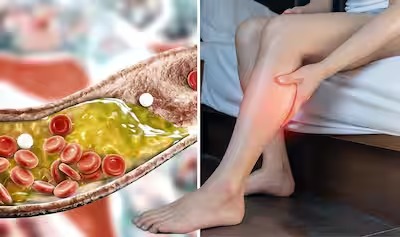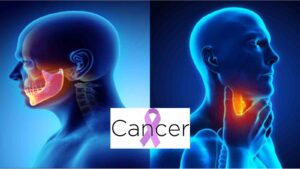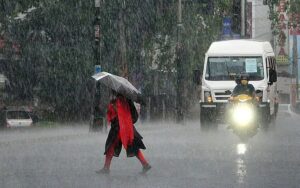The Hidden Risks of High Cholesterol: How Blocked Arteries in the Legs and Feet Can Signal Heart Trouble

The Hidden Risks of High Cholesterol: How Blocked Arteries in the Legs and Feet Can Signal Heart Trouble
When it comes to heart health, the quiet hours of the night can reveal underlying dangers that often go unnoticed during the day. High cholesterol, a common yet potentially hazardous condition, has far-reaching impacts beyond the heart, particularly affecting the legs and feet. Understanding these symptoms and their implications is crucial for maintaining overall cardiovascular health.
Understanding the Impact of High Cholesterol
Cholesterol, a waxy substance vital for creating new cells and hormones, is essential for the body. However, when levels become too high, it poses significant risks, particularly to the heart. Excess cholesterol can lead to atherosclerosis, a condition where the arteries become clogged with fatty deposits, restricting blood flow and increasing the risk of heart diseases, including heart attacks.
Nighttime Signals of Blocked Arteries
Symptoms of blocked arteries are often more pronounced at night, especially in the legs and feet. This occurs because cholesterol can accumulate in the arteries of the heart and extremities, impeding proper blood flow. Recognizing these symptoms early is crucial for preventing serious complications.
Key Symptoms to Watch For:
- Pain and Discomfort in Legs and Feet: Often noticeable during physical activity or at night, this pain can be a sign of claudication, which is caused by narrowed arteries.
- Numbness or Weakness: A reduction in blood flow can cause the legs and feet to feel weak or numb, especially during rest.
- Persistent Cold Feet: Even in warm environments, decreased circulation can result in cold feet.
- Swelling: Poor circulation can lead to fluid build-up, which often worsens by the end of the day and can signal heart blockages.
- Change in Skin Color: A blue or purple kind of tint to the skin of the legs and the feet can indicate a severe circulation issue.
- Slow-Healing Sores: Wounds especially on the lower limbs that do not heal promptly might suggest a significant presence of artery blockages.
- Massive Hair Loss on Legs and Feet: Reduced hair growth or complete hair loss in these areas can also be a symptom of blocked arteries.
Acting Against High Cholesterol
Experiencing any of these symptoms, particularly at night, warrants a visit to a healthcare provider. Early detection and treatment of high cholesterol are essential for preventing severe heart-related complications. Managing cholesterol levels involves lifestyle changes such as maintaining a balanced diet, engaging in regular physical activity, and having consistent health check-ups.
Decoding Peripheral Artery Disease (PAD)
Peripheral artery disease (PAD) is a serious condition characterized by narrowed arteries, reducing blood flow to the limbs, especially the legs. Atherosclerosis is the primary cause of this condition, which is the buildup of fatty deposits in the arteries.
Symptoms of PAD Include:
- Claudication: Muscle pain or cramping which happens in the legs and is triggered by physical activity and relieved by rest is called claudication.
- Temperature Differences: Coldness in the calf, ankles or foot compared to the other side of the leg.
- Numbness or Weakness: These symptoms can indicate severe blood flow restrictions in several parts of the body, especially the hands and legs.
- Changes in Skin Appearance: Shiny or glowy skin, colour changes, and slow nail growth are all indicative signs.
- Non-healing Sores: Persistent sores on the feet or legs similar to high cholesterol symptoms are one of the severe symptoms requiring immediate medical attention.
When to Seek Medical Help
Symptoms like leg pain, numbness, and physical changes should prompt an immediate visit to a healthcare provider. Early detection of PAD is integral in order to manage the symptoms and prevent complications such as critical limb ischemia, which could lead to amputation or even increase the risk of a heart attack or stroke.
Preventative Strategies for PAD:
- Avoid Smoking: Smoking cessation is critical for managing PAD.
- Manage Blood Sugar and Cholesterol: Keeping these within the recommended ranges is necessary.
- Healthy Diet and Exercise: Adopting a diet low in saturated fats and engaging in regular exercise can help but consult a healthcare provider first.
- Regular Check-ups: Monitoring your blood pressure and overall health can help catch PAD before, in its early stages.
High cholesterol and peripheral artery disease are interconnected conditions that significantly impact circulation and overall health. Recognizing the subtle signs, especially those that manifest at night, is key to preventing the severe consequences of these widespread health issues.
The silent symptoms of high cholesterol and PAD, particularly those that emerge during the quiet of the night, are warning signs that should not be ignored. By understanding these signals and taking proactive measures, individuals can safeguard their heart health and improve their overall well-being. Maintaining a balanced diet, staying active, and regularly consulting with healthcare providers are fundamental steps in managing cholesterol levels and preventing the serious complications associated with blocked arteries.







